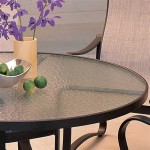Patio Herb Planter Ideas: Cultivating Flavor and Beauty Outdoors
Transforming a patio into a vibrant and aromatic herb garden is a rewarding endeavor. It provides easy access to fresh, flavorful ingredients for culinary creations while enhancing the aesthetic appeal of outdoor living spaces. Choosing the right herb planter and employing effective planting strategies are essential for establishing a thriving patio herb garden. This article explores diverse patio herb planter ideas, providing insights into selecting suitable planters, optimizing growing conditions, and designing an aesthetically pleasing and functional herb garden.
Selecting the Right Herb Planters for Your Patio
The success of a patio herb garden hinges significantly on the selection of appropriate planters. Several factors, including material, size, drainage, and aesthetic compatibility with the patio's overall design, must be considered. Each planter type offers distinct advantages and disadvantages that influence growing conditions and maintenance requirements.
Terracotta Pots: Terracotta pots are a classic choice for herb gardens, providing excellent aeration and drainage. The porous nature of terracotta allows air to circulate through the soil, preventing root rot and promoting healthy growth. However, terracotta dries out quickly, requiring more frequent watering, particularly in hot and sunny climates. These pots are also susceptible to cracking in freezing temperatures, making them less suitable for regions with harsh winters unless adequately protected or moved indoors. The natural, earthy tone of terracotta complements various patio styles, offering a rustic and timeless appeal.
Ceramic Pots: Ceramic pots offer a balance of aesthetics and functionality. They retain moisture better than terracotta, reducing the frequency of watering. Ceramic planters are available in a wide range of colors, patterns, and finishes, enabling gardeners to match their planters to the patio's decor. Ensure that ceramic pots have adequate drainage holes to prevent waterlogging, which can lead to root rot. Although more durable than terracotta, ceramic pots can still crack under extreme temperature fluctuations.
Plastic Pots: Plastic pots are a lightweight and cost-effective option for patio herb gardens. They retain moisture exceptionally well, requiring less frequent watering compared to terracotta. Plastic planters are available in various shapes, sizes, and colors, offering versatility in design. However, plastic is non-porous, potentially leading to poor aeration and increased risk of root rot if drainage is inadequate. Opt for high-quality, UV-resistant plastic to prevent degradation from sun exposure. Consider using dark-colored plastic pots sparingly, as they can absorb heat and raise soil temperatures excessively.
Metal Containers: Metal containers, such as galvanized steel or aluminum pots, offer a modern and industrial aesthetic. They are durable and weather-resistant, making them suitable for outdoor use. Metal can heat up quickly in direct sunlight, so consider lining the inside of the container with plastic or fabric to protect the roots from excessive heat. Ensure that metal containers have drainage holes to prevent water accumulation. Some metals may leach into the soil over time, potentially affecting plant growth, so choose food-safe or treated metal containers for herb gardens.
Wooden Planters: Wooden planters provide a natural and rustic charm to patio herb gardens. Cedar and redwood are naturally rot-resistant and are excellent choices for outdoor use. Line wooden planters with plastic sheeting or landscape fabric to prevent the wood from direct contact with the soil, extending the lifespan of the planter. Ensure adequate drainage to prevent waterlogging and wood rot. Consider the weight of the filled planter, as wooden containers can become quite heavy when filled with soil and plants.
Self-Watering Planters: Self-watering planters are designed to provide a consistent supply of moisture to the plants, reducing the need for frequent watering. These planters typically have a reservoir at the bottom that holds water, which is then drawn up into the soil via capillary action. Self-watering planters are particularly useful for gardeners who have limited time for watering or live in hot and dry climates. Choose self-watering planters that are appropriately sized for the herbs being grown and ensure that the reservoir is regularly refilled.
Vertical Planters: Vertical planters are ideal for small patios or balconies, maximizing space utilization. These planters can be mounted on walls or fences, creating a visually appealing and space-saving herb garden. Options include tiered planters, hanging baskets, and wall-mounted pockets. Vertical planters require careful watering management, as the upper tiers tend to dry out faster than the lower tiers. Choose herbs that have similar water requirements for optimal performance.
Optimizing Growing Conditions for Patio Herbs
Creating optimal growing conditions is crucial for the success of a patio herb garden. Factors such as sunlight, soil, watering, and fertilization significantly impact the health and productivity of the plants. Understanding the specific needs of each herb species is essential for providing the appropriate environment for thriving growth.
Sunlight Requirements: Most herbs thrive in full sun, requiring at least six hours of direct sunlight per day. However, some herbs, such as mint and parsley, can tolerate partial shade. Observe the amount of sunlight your patio receives throughout the day and choose herbs that are best suited to the available light conditions. Position planters strategically to maximize sun exposure, and consider using reflective surfaces to increase light intensity in shady areas. If insufficient natural light is available, supplemental grow lights can be used to provide the necessary illumination.
Soil Selection: The quality of the soil directly impacts the growth and health of patio herbs. Use a well-draining potting mix that is specifically formulated for container gardening. Avoid using garden soil, as it can become compacted in containers and impede drainage. Amend the potting mix with compost or other organic matter to improve fertility and water retention. A slightly acidic to neutral pH (around 6.0 to 7.0) is ideal for most herbs. Test the soil periodically and adjust the pH as needed.
Watering Practices: Proper watering is essential for maintaining a healthy patio herb garden. Overwatering and underwatering can both lead to plant stress and reduced yields. Water deeply and thoroughly when the top inch of soil feels dry to the touch. Avoid frequent, shallow watering, as this encourages shallow root growth. The watering frequency will vary depending on the type of herb, the size of the planter, and the weather conditions. Monitor the soil moisture regularly and adjust the watering schedule accordingly. Use a watering can with a gentle rose to avoid damaging delicate leaves and stems. Water early in the morning to allow the foliage to dry before nightfall, reducing the risk of fungal diseases.
Fertilization: Herbs generally do not require heavy fertilization, but regular feeding with a balanced organic fertilizer can promote healthy growth and abundant yields. Choose a fertilizer that is specifically formulated for herbs or vegetables. Follow the instructions on the fertilizer label carefully to avoid over-fertilizing, which can lead to nutrient imbalances and plant damage. Apply fertilizer during the growing season, typically from spring to fall. Compost tea or liquid seaweed extract can be used as a gentle and natural fertilizer.
Pruning and Harvesting: Regular pruning and harvesting are essential for maintaining a productive and attractive patio herb garden. Pruning encourages bushier growth and prevents herbs from becoming leggy. Harvest herbs frequently to stimulate new growth and prevent flowering, which can reduce the flavor of the leaves. Use sharp, clean scissors or pruning shears to avoid damaging the plants. Harvest herbs in the morning, after the dew has dried, for the best flavor. Store harvested herbs properly to preserve their freshness and flavor.
Pest and Disease Management: Monitor patio herbs regularly for signs of pests and diseases. Early detection and prompt treatment can prevent infestations from becoming severe. Common herb pests include aphids, spider mites, and whiteflies. Control pests with insecticidal soap, neem oil, or horticultural oil. Remove diseased leaves promptly to prevent the spread of infection. Ensure good air circulation around the plants to reduce the risk of fungal diseases. Avoid overhead watering, which can create a humid environment that promotes disease development. Consider companion planting to deter pests and attract beneficial insects.
Designing an Aesthetically Pleasing and Functional Herb Garden
Beyond the practical benefits of fresh herbs, a patio herb garden can enhance the visual appeal of outdoor living spaces. Careful planning and design can transform a simple collection of planters into a captivating and functional garden feature. Considering the overall aesthetic of the patio and incorporating herbs with varying textures, colors, and growth habits can create a visually stimulating and inviting space.
Container Grouping: Arranging herb planters in visually appealing groupings can create a focal point on the patio. Group planters of varying heights and sizes to add visual interest. Consider using a combination of terracotta, ceramic, and metal planters to create a diverse and eclectic look. Place taller planters at the back of the grouping and shorter planters in the front to ensure that all plants receive adequate sunlight. Repeat colors and textures throughout the grouping to create a cohesive and unified design.
Color and Texture Combinations: Incorporating herbs with varying leaf colors and textures can add visual interest to the patio herb garden. Combine herbs with contrasting foliage, such as purple basil, silver thyme, and variegated mint. Use herbs with different leaf shapes and sizes to create textural contrast. Flowering herbs, such as lavender and chamomile, can add pops of color and attract pollinators to the garden. Consider the overall color palette of the patio and choose herbs that complement the existing decor.
Edible Flowers: Incorporating edible flowers into the herb garden adds both beauty and flavor to culinary creations. Nasturtiums, pansies, and violets are examples of edible flowers that can be used to garnish salads, desserts, and beverages. Choose edible flowers that are pesticide-free and grown specifically for consumption. Research the flavor profiles of different edible flowers to ensure that they complement the herbs being grown. Edible flowers also attract pollinators to the garden, enhancing biodiversity and promoting healthy growth.
Fragrant Herbs: Planting fragrant herbs near seating areas can create a relaxing and aromatic ambiance. Lavender, rosemary, and lemon balm are examples of herbs that release a pleasant scent when brushed against or touched. Consider the intensity of the fragrance and choose herbs that are not overpowering. Plant fragrant herbs in containers near doorways or walkways to welcome visitors with a delightful aroma.
Labeling and Organization: Labeling each herb planter helps to identify the plants and track their care requirements. Use attractive plant markers or labels that complement the overall design of the patio. Organize herbs according to their sunlight, water, and soil preferences to ensure optimal growing conditions. Group herbs that are commonly used together in culinary applications for easy access. Consider creating a map of the herb garden to keep track of plant locations and maintenance schedules.
Vertical Gardening Elements: Incorporating vertical gardening elements, such as trellises or hanging baskets, can add height and dimension to the patio herb garden. Train climbing herbs, such as thyme or creeping rosemary, to grow up a trellis. Hang baskets filled with trailing herbs, such as cascading thyme or creeping jenny, from the patio railing or pergola. Vertical gardening elements maximize space utilization and create a visually stunning focal point.
Integration with Patio Furniture: Integrate the herb garden seamlessly with the existing patio furniture to create a cohesive and inviting outdoor living space. Place herb planters around seating areas to provide shade and privacy. Use herb planters as decorative accents on tables and shelves. Incorporate herbs into centerpieces and floral arrangements. Consider the scale and style of the patio furniture when selecting herb planters to ensure a harmonious and balanced design.

How To Start A Balcony Herb Garden Access S

How To Start A Balcony Herb Garden Access S

Diy Vertical Garden 14 Ways To Grow Up Bob Vila

26 Ive Diy Porch Herb Garden Ideas Balcony Web

8 Balcony Herb Garden Ideas You Would Like To Try

How To Make A Balcony Herb Garden Complete Tutorial

8 Balcony Herb Garden Ideas You Would Like To Try

Outdoor Herb Garden Ideas The Idea Room

Easy Diy Patio Herb Garden Step By With S

60 Diy Herb Garden Ideas Prudent Penny Pincher








